technical specifications Seat Alhambra 2011 User Guide
[x] Cancel search | Manufacturer: SEAT, Model Year: 2011, Model line: Alhambra, Model: Seat Alhambra 2011Pages: 385, PDF Size: 7.92 MB
Page 287 of 385
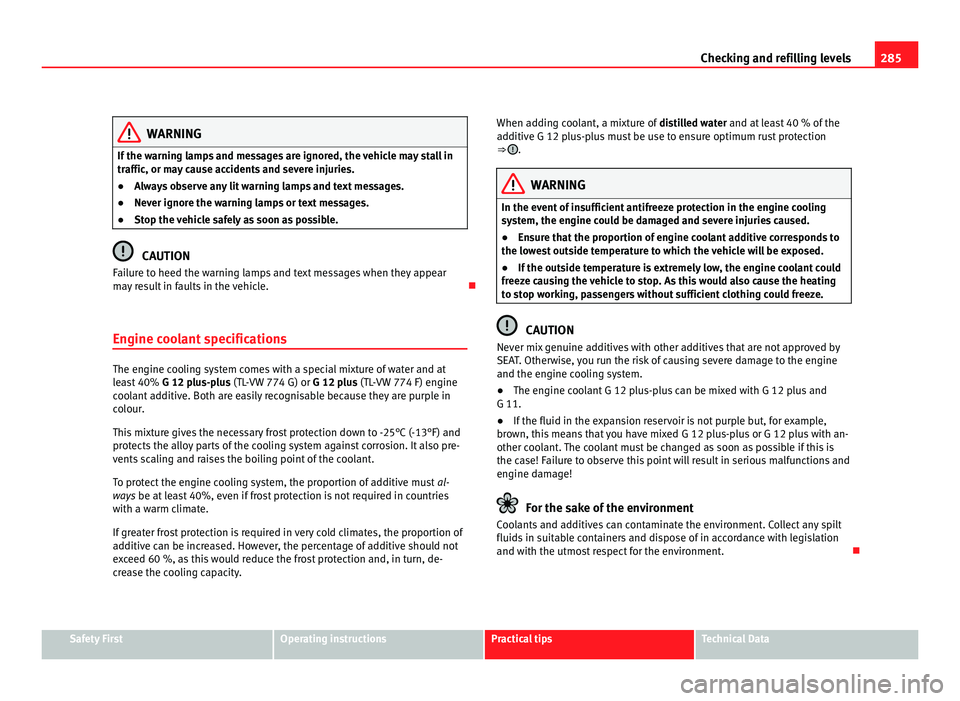
285
Checking and refilling levels WARNING
If the warning lamps and messages are ignored, the vehicle may stall in
traffic, or m a
y cause accidents and severe injuries.
● Always observe any lit warning lamps and text messages.
● Never ignore the warning lamps or text messages.
● Stop the vehicle safely as soon as possible. CAUTION
Failure to heed the warning lamps and text messages when they appear
ma y
result in faults in the vehicle.
Engine coolant specifications The engine cooling system comes with a special mixture of water and at
le
a
st 40% G 12 plus-plus (TL-VW 774 G) or G 12 plus (TL-VW 774 F) engine
coolant additive. Both are easily recognisable because they are purple in
colour.
This mixture gives the necessary frost protection down to -25°C (-13°F) and
protects the alloy parts of the cooling system against corrosion. It also pre-
vents scaling and raises the boiling point of the coolant.
To protect the engine cooling system, the proportion of additive must al-
ways be at least 40%, even if frost protection is not required in countries
with a warm climate.
If greater frost protection is required in very cold climates, the proportion of
additive can be increased. However, the percentage of additive should not
exceed 60 %, as this would reduce the frost protection and, in turn, de-
crease the cooling capacity. When adding coolant, a mixture of
disti
lled water and at least 40 % of the
additive G 12 plus-plus must be use to ensure optimum rust protection
⇒ .
WARNING
In the event of insufficient antifreeze protection in the engine cooling
sys t
em, the engine could be damaged and severe injuries caused.
● Ensure that the proportion of engine coolant additive corresponds to
the lowe
st outside temperature to which the vehicle will be exposed.
● If the outside temperature is extremely low, the engine coolant could
freeze c
ausing the vehicle to stop. As this would also cause the heating
to stop working, passengers without sufficient clothing could freeze. CAUTION
Never mix genuine additives with other additives that are not approved by
SEA T
. Otherwise, you run the risk of causing severe damage to the engine
and the engine cooling system.
● The engine coolant G 12 plus-plus can be mixed with G 12 plus and
G 11.
● If the fluid in the expansion reservoir is not purple but, for example,
brown, thi
s means that you have mixed G 12 plus-plus or G 12 plus with an-
other coolant. The coolant must be changed as soon as possible if this is
the case! Failure to observe this point will result in serious malfunctions and
engine damage! For the sake of the environment
Coolants and additives can contaminate the environment. Collect any spilt
fluids in s
uitable containers and dispose of in accordance with legislation
and with the utmost respect for the environment. Safety First Operating instructions Practical tips Technical Data
Page 293 of 385
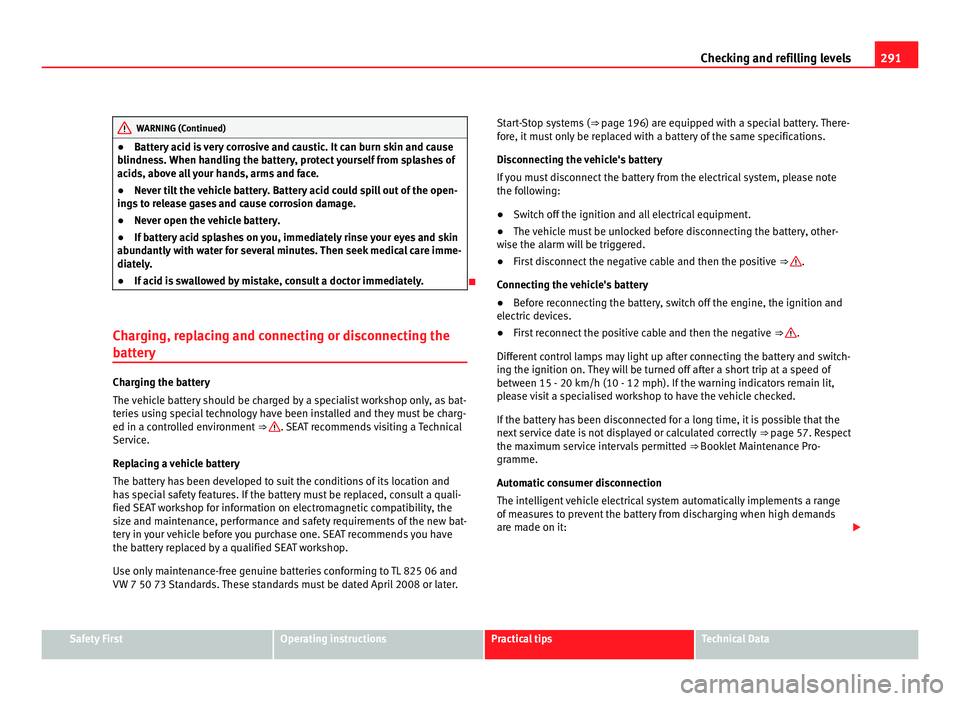
291
Checking and refilling levels WARNING (Continued)
● Battery acid is very corrosive and caustic. It can burn skin and cause
b lindne
ss. When handling the battery, protect yourself from splashes of
acids, above all your hands, arms and face.
● Never tilt the vehicle battery. Battery acid could spill out of the open-
ings
to release gases and cause corrosion damage.
● Never open the vehicle battery.
● If battery acid splashes on you, immediately rinse your eyes and skin
abund
antly with water for several minutes. Then seek medical care imme-
diately.
● If acid is swallowed by mistake, consult a doctor immediately.
Charging, replacing and connecting or disconnecting the
batt er
y Charging the battery
The v
ehic
le battery should be charged by a specialist workshop only, as bat-
teries using special technology have been installed and they must be charg-
ed in a controlled environment ⇒ . SEAT recommends visiting a Technical
Serv ic
e.
Replacing a vehicle battery
The battery has been developed to suit the conditions of its location and
has special safety features. If the battery must be replaced, consult a quali-
fied SEAT workshop for information on electromagnetic compatibility, the
size and maintenance, performance and safety requirements of the new bat-
tery in your vehicle before you purchase one. SEAT recommends you have
the battery replaced by a qualified SEAT workshop.
Use only maintenance-free genuine batteries conforming to TL 825 06 and
VW 7 50 73 Standards. These standards must be dated April 2008 or later. Start-Stop systems (
⇒ page 196) ar
e equipped with a special battery. There-
fore, it must only be replaced with a battery of the same specifications.
Disconnecting the vehicle's battery
If you must disconnect the battery from the electrical system, please note
the following:
● Switch off the ignition and all electrical equipment.
● The vehicle must be unlocked before disconnecting the battery, other-
wise the al
arm will be triggered.
● First disconnect the negative cable and then the positive ⇒ .
Connectin g the
vehicle's battery
● Before reconnecting the battery, switch off the engine, the ignition and
electric dev
ices.
● First reconnect the positive cable and then the negative ⇒ .
Differ ent
control lamps may light up after connecting the battery and switch-
ing the ignition on. They will be turned off after a short trip at a speed of
between 15 - 20 km/h (10 - 12 mph). If the warning indicators remain lit,
please visit a specialised workshop to have the vehicle checked.
If the battery has been disconnected for a long time, it is possible that the
next service date is not displayed or calculated correctly ⇒ page 57. Respect
the maximum service intervals permitted ⇒ Booklet Maintenance Pro-
gramme.
Automatic consumer disconnection
The intelligent vehicle electrical system automatically implements a range
of measures to prevent the battery from discharging when high demands
are made on it: Safety First Operating instructions Practical tips Technical Data
Page 305 of 385

303
Wheels and tyres Tyre code (example) Meaning
DOT BT RA TY5 1709 Tyre identification number (TIN
a)
, ma y be only on
interior wall of wheel) and date of manufacture: DOT The tyre complies with the legal require-
ments of
the US
Department of Trans-
port, responsible for tyre safety regula-
tions. BT Place of manufacture code.
RA Information about manufacturer and tyre
siz
e. TY5 Manufacturer's tyre specifications.
1709 Date of manufacture: Week 17 of 2009.
TWI This identifies the position of the Tread Wear In-
dicat
or
⇒ page 298. MAX LOAD 615 KG
(1356 LBS) US load rating, indicating maximum permitted
loa
d per ty
re. MAX INFLATION 350 KPA
(51 PSI) US limit, indicating maximum permitted tyre
pre
s
sure. SIDEWALL 1 PLY RAYON Information about tyre wall components:
1 la
y
er of rayon (artificial silk). TREAD 4 PLIES
1 RAY
ON + 2
STEEL +
1 NYLON Information about tread components:
In the ex
amp
le, there are 4 layers below the
tread: 1 layer of rayon (artificial silk), 2 layers of
steel reinforcement and 1 layer of nylon. Information for the end consumer concerning the comparative values of
the es
t
ablished base tyres (standardised test procedures) :TREADWEAR 280 Relative service life of the tyre, with respect to
spec
ific
US standard test. TRACTION AA Braking capacity of tyre on wet surface (AA, A, B
or C). Tyre code (example) Meaning
TEMPERATURE A Tyre temperature resistance at higher test
speed
s
(A, B or C). If there are different letters, they are specific codes of the tyre manufac-
tur
er or s
pecific national codes. a)
The letters TIN refer to the tyre serial number.
Ty r
es with directional tread pattern
Tyres with directional tread pattern have been designed to operate best
when rotating in only one direction. An arrow on the tyre sidewall indicates
the direction of rotation on tyres with directional tread. Always observe the
direction of rotation indicated when mounting the wheel. This guarantees
optimum grip and helps to avoid aquaplaning, excessive noise and wear.
Tyre load rating
The load rating code indicates the maximum load in kilogrammes each
wheel can carry (load capacity).
615 kg (1356 pounds)
650 kg (1433 pounds)
690 kg (1521 pounds)
730 kg (1609 pounds)
775 kg (1709 pounds)
Speed rating
The speed rating indicates the maximum speed permitted for the tyres.
max. 150 km/h (93 mph)
max. 160 km/h (99 mph)
max. 170 km/h (106 mph)
max. 180 km/h (112 mph)
max. 190 km/h (118 mph)
max. 200 km/h (124 mph)
91
93
95
97
99
P
Q
R
S
T
U
Safety First Operating instructions Practical tips Technical Data
Page 328 of 385
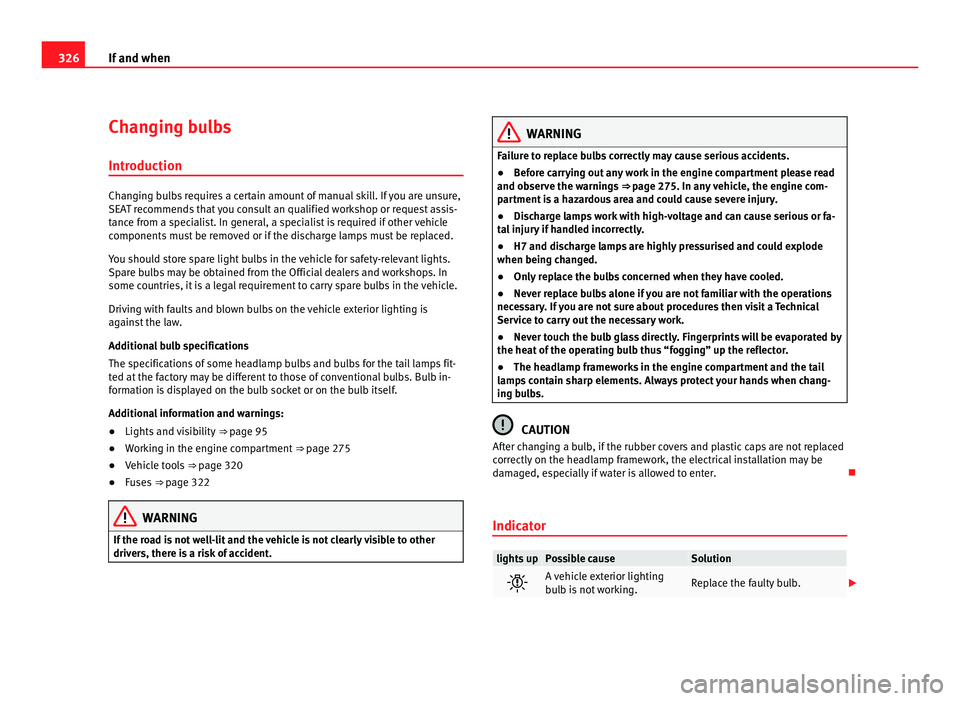
326
If and when
Changing bulbs
Introduction Changing bulbs requires a certain amount of manual skill. If you are unsure,
SEA
T r
ecommends that you consult an qualified workshop or request assis-
tance from a specialist. In general, a specialist is required if other vehicle
components must be removed or if the discharge lamps must be replaced.
You should store spare light bulbs in the vehicle for safety-relevant lights.
Spare bulbs may be obtained from the Official dealers and workshops. In
some countries, it is a legal requirement to carry spare bulbs in the vehicle.
Driving with faults and blown bulbs on the vehicle exterior lighting is
against the law.
Additional bulb specifications
The specifications of some headlamp bulbs and bulbs for the tail lamps fit-
ted at the factory may be different to those of conventional bulbs. Bulb in-
formation is displayed on the bulb socket or on the bulb itself.
Additional information and warnings:
● Lights and visibility ⇒ page 95
● W
orking in the engine compartment ⇒ page 275
● V
ehicle tools ⇒ page 320
● F
uses ⇒ page 322 WARNING
If the road is not well-lit and the vehicle is not clearly visible to other
driver s, ther
e is a risk of accident. WARNING
Failure to replace bulbs correctly may cause serious accidents.
● Before carrying out any work in the engine compartment please read
and ob ser
ve the warnings ⇒ page 275. In any vehicle, the engine com-
partment is a hazardous area and could cause severe injury.
● Discharge lamps work with high-voltage and can cause serious or fa-
tal
injury if handled incorrectly.
● H7 and discharge lamps are highly pressurised and could explode
when being ch
anged.
● Only replace the bulbs concerned when they have cooled.
● Never replace bulbs alone if you are not familiar with the operations
neces
sary. If you are not sure about procedures then visit a Technical
Service to carry out the necessary work.
● Never touch the bulb glass directly. Fingerprints will be evaporated by
the heat of
the operating bulb thus “fogging” up the reflector.
● The headlamp frameworks in the engine compartment and the tail
lamps
contain sharp elements. Always protect your hands when chang-
ing bulbs. CAUTION
After changing a bulb, if the rubber covers and plastic caps are not replaced
corr ectly
on the headlamp framework, the electrical installation may be
damaged, especially if water is allowed to enter.
Indicator lights up Possible cause Solution
A vehicle exterior lighting
bu
l
b is not working. Replace the faulty bulb.
Page 351 of 385

349
Technical Data
Petrol engine 1.4 110 kW (150 PS) Engine specifications
Power output in kW (PS) rpm 110 (150)/ 5800
Maximum torque in Nm at rpm 240/ 1500-4000
No. of cylinders/capacity in cm3
4/ 1390
Fuel 95 super RON a)a)
Research-Octane-Number = Anti-detonation rating of the petrol.
P er
formance figures
Maximum speed in km/h 197
Acceleration from 0-80 km/h in sec. 6.9
Acceleration from 0-100 km/h in sec. 10.7Consumption (litres/100 km)/ CO
2 (g/km)
Urban cycle 9.2/214
Extra urban cycle 6.1/143
Combined 7.2/167Weights
5 seats 7 seats
Gross vehicle weight in kg 2290 2480
Weight in running order (with driver) in kg 1723 1771
Gross front axle weight in kg 1170/1220 1170/1220
Gross rear axle weight in kg 1070/1120 1260/1310
Permitted roof load in kg 100 100Safety First Operating instructions Practical tips Technical Data
Page 352 of 385

350
Technical Data
Trailer weight Trailer without brakes 750
Trailer with brakes, gradients up to 8% 1800
Trailer with brakes, gradients up to 12% 1800Engine oil capacity
Approximate engine oil capacity with oil filter change 3.6
Petrol engine 1.4 110 kW (150 HP). Automatic Engine specifications
Power output in kW (PS) rpm 110 (150)/ 5800
Maximum torque in Nm at rpm 240/ 1500-4000
No. of cylinders/capacity in cm3
4/ 1390
Fuel 95 super RON a)a)
Research-Octane-Number = Anti-detonation rating of the petrol.
P er
formance figures
Maximum speed in km/h 197
Acceleration from 0-80 km/h in sec. 6.6
Acceleration from 0-100 km/h in sec. 9.9Consumption (litres/100 km)/ CO
2 (g/km)
Urban cycle 9.4/218
Extra urban cycle 6.6/154
Combined 7.6/178
Page 353 of 385
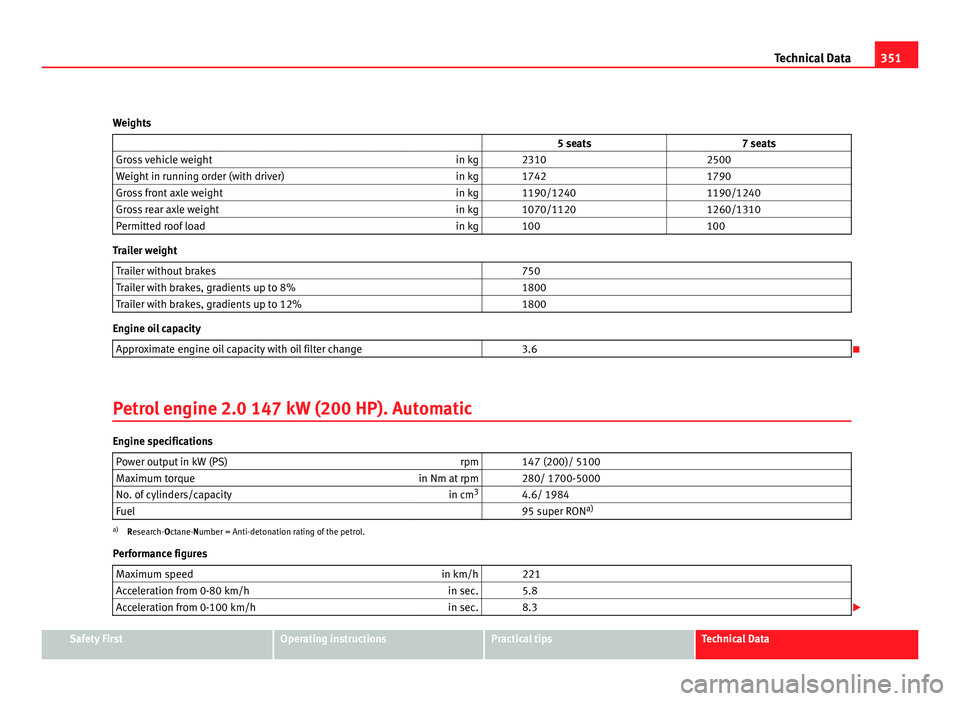
351
Technical Data
Weights 5 seats 7 seats
Gross vehicle weight in kg 2310 2500
Weight in running order (with driver) in kg 1742 1790
Gross front axle weight in kg 1190/1240 1190/1240
Gross rear axle weight in kg 1070/1120 1260/1310
Permitted roof load in kg 100 100Trailer weight
Trailer without brakes 750
Trailer with brakes, gradients up to 8% 1800
Trailer with brakes, gradients up to 12% 1800Engine oil capacity
Approximate engine oil capacity with oil filter change 3.6
Petrol engine 2.0 147 kW (200 HP). Automatic Engine specifications
Power output in kW (PS) rpm 147 (200)/ 5100
Maximum torque in Nm at rpm 280/ 1700-5000
No. of cylinders/capacity in cm3
4.6/ 1984
Fuel 95 super RON a)a)
Research-Octane-Number = Anti-detonation rating of the petrol.
P er
formance figures
Maximum speed in km/h 221
Acceleration from 0-80 km/h in sec. 5.8
Acceleration from 0-100 km/h in sec. 8.3 Safety First Operating instructions Practical tips Technical Data
Page 354 of 385
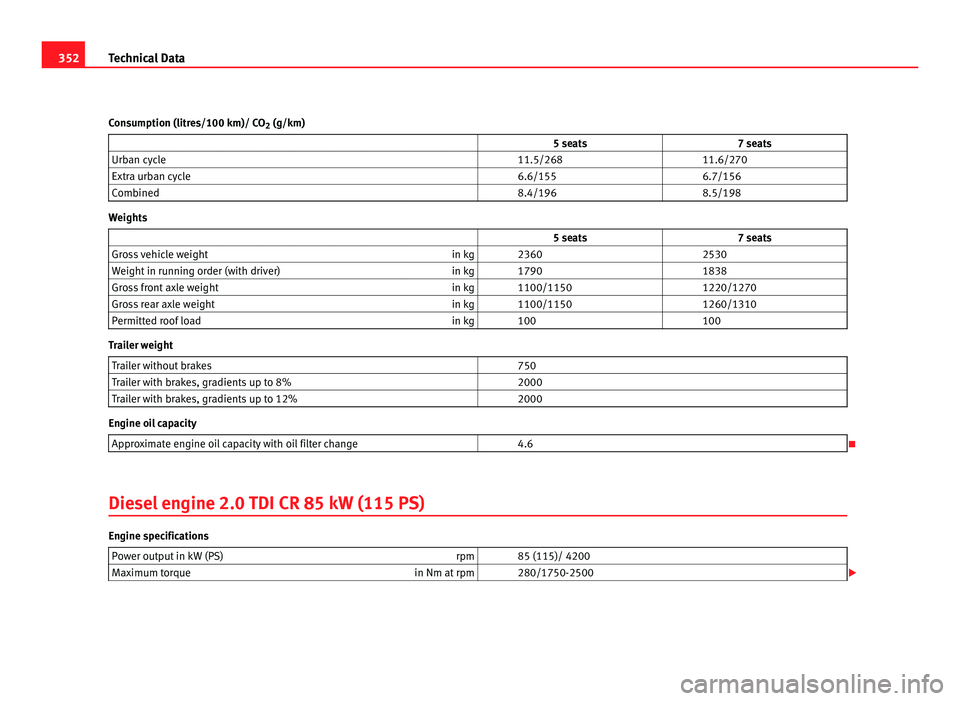
352
Technical Data
Consumption (litres/100 km)/ CO 2 (g/km)
5 seats 7 seats
Urban cycle 11.5/268 11.6/270
Extra urban cycle 6.6/155 6.7/156
Combined 8.4/196 8.5/198Weights
5 seats 7 seats
Gross vehicle weight in kg 2360 2530
Weight in running order (with driver) in kg 1790 1838
Gross front axle weight in kg 1100/1150 1220/1270
Gross rear axle weight in kg 1100/1150 1260/1310
Permitted roof load in kg 100 100Trailer weight
Trailer without brakes 750
Trailer with brakes, gradients up to 8% 2000
Trailer with brakes, gradients up to 12% 2000Engine oil capacity
Approximate engine oil capacity with oil filter change 4.6
Diesel engine 2.0 TDI CR 85 kW (115 PS) Engine specifications
Power output in kW (PS) rpm 85 (115)/ 4200
Maximum torque in Nm at rpm 280/1750-2500
Page 356 of 385
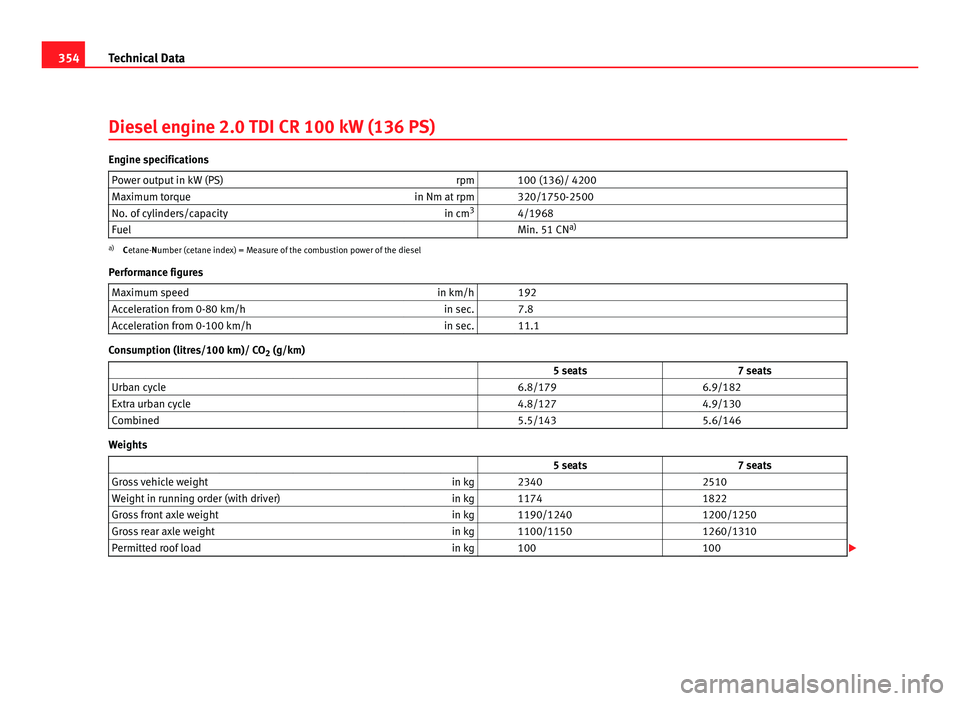
354
Technical Data
Diesel engine 2.0 TDI CR 100 kW (136 PS) Engine specifications
Power output in kW (PS) rpm 100 (136)/ 4200
Maximum torque in Nm at rpm 320/1750-2500
No. of cylinders/capacity in cm3
4/1968
Fuel Min. 51 CN a)a)
Cetane-Number (cetane index) = Measure of the combustion power of the diesel
P er
formance figures
Maximum speed in km/h 192
Acceleration from 0-80 km/h in sec. 7.8
Acceleration from 0-100 km/h in sec. 11.1Consumption (litres/100 km)/ CO
2 (g/km)
5 seats 7 seats
Urban cycle 6.8/179 6.9/182
Extra urban cycle 4.8/127 4.9/130
Combined 5.5/143 5.6/146Weights
5 seats 7 seats
Gross vehicle weight in kg 2340 2510
Weight in running order (with driver) in kg 1174 1822
Gross front axle weight in kg 1190/1240 1200/1250
Gross rear axle weight in kg 1100/1150 1260/1310
Permitted roof load in kg 100 100
Page 357 of 385
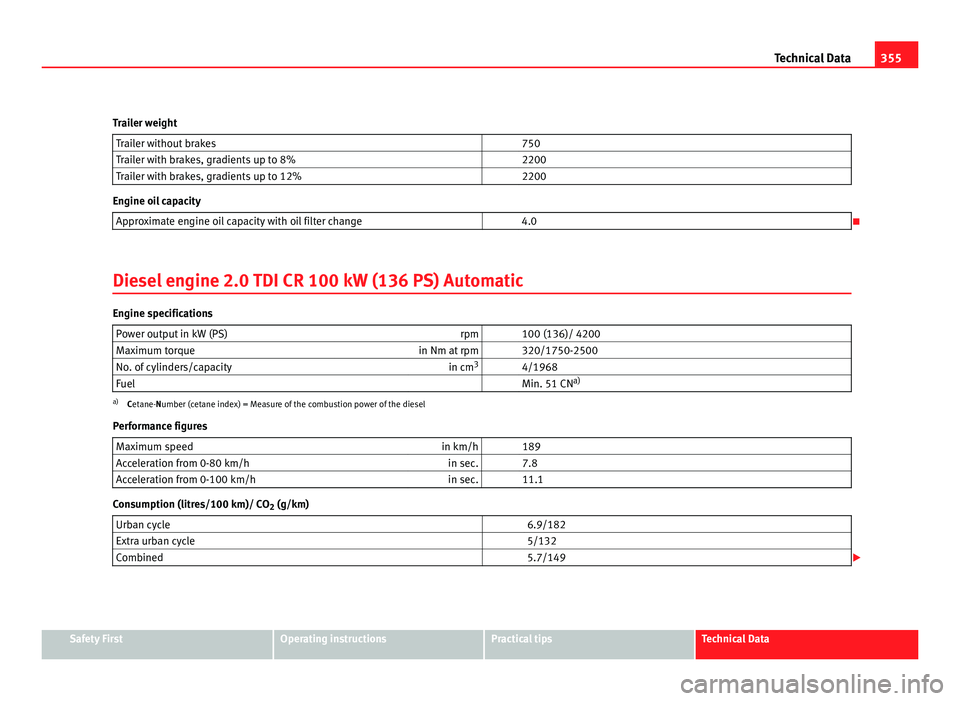
355
Technical Data
Trailer weight Trailer without brakes 750
Trailer with brakes, gradients up to 8% 2200
Trailer with brakes, gradients up to 12% 2200Engine oil capacity
Approximate engine oil capacity with oil filter change 4.0
Diesel engine 2.0 TDI CR 100 kW (136 PS) Automatic Engine specifications
Power output in kW (PS) rpm 100 (136)/ 4200
Maximum torque in Nm at rpm 320/1750-2500
No. of cylinders/capacity in cm3
4/1968
Fuel Min. 51 CN a)a)
Cetane-Number (cetane index) = Measure of the combustion power of the diesel
P er
formance figures
Maximum speed in km/h 189
Acceleration from 0-80 km/h in sec. 7.8
Acceleration from 0-100 km/h in sec. 11.1Consumption (litres/100 km)/ CO
2 (g/km)
Urban cycle 6.9/182
Extra urban cycle 5/132
Combined 5.7/149Safety First Operating instructions Practical tips Technical Data